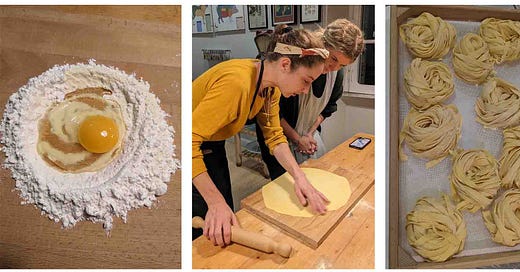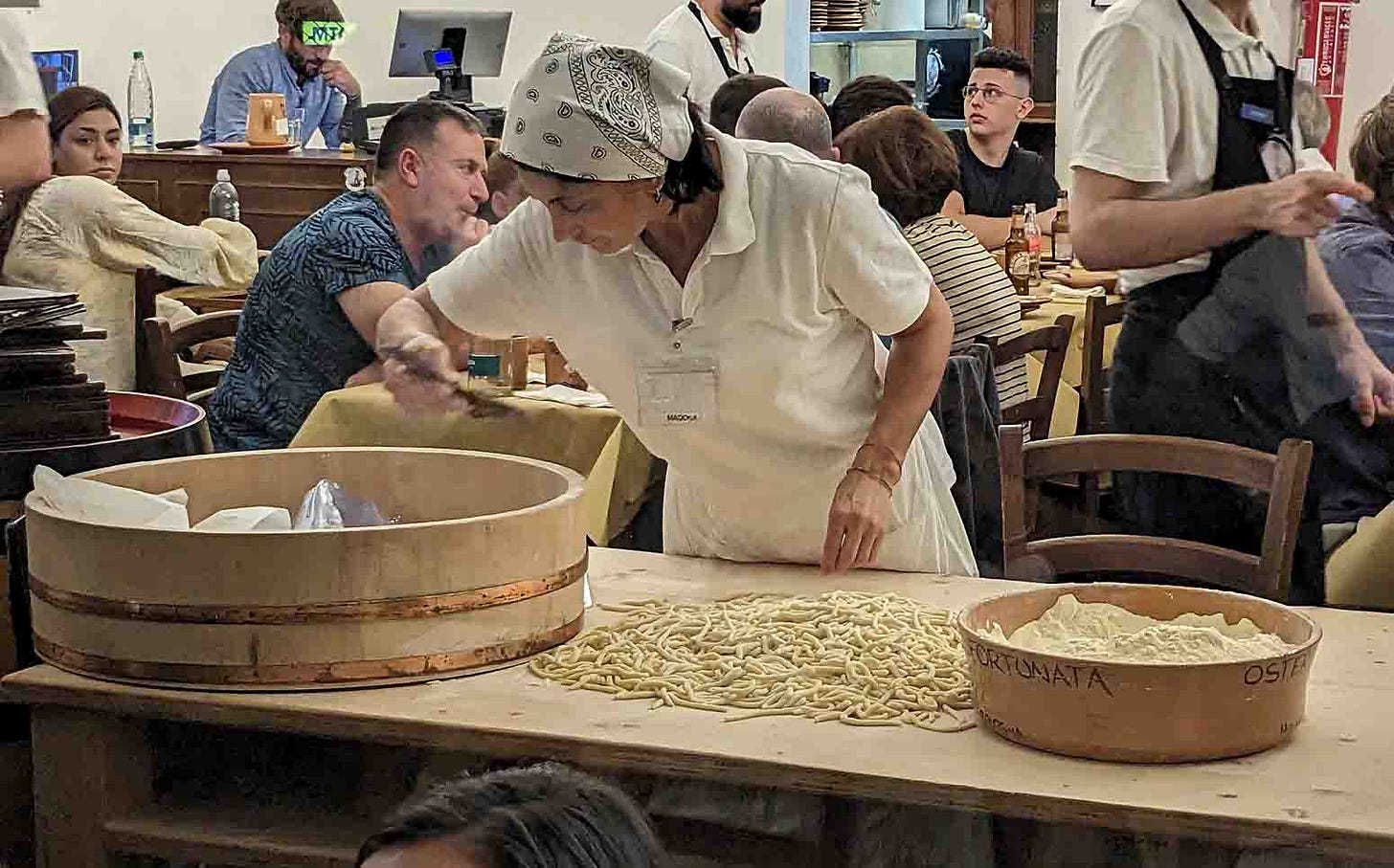Like so many other aspects of Italian culture, there is a north south divide in Italy when it comes to pasta.
Southern Italy is the origin for what we generally think of as pasta in the United States. In Italy, this is pasta secca, or dried pasta. It is made exclusively with durum wheat, also known as semolina, called grano duro (hard wheat) in Italian. Durum wheat is actually a different species – it is Triticum durum, rather than the much more commonly cultivated Triticum aestivum that is known as common wheat or bread wheat. Approximately 95% of the wheat cultivated in the world is common wheat.
Durum wheat is significantly harder and more difficult to grind: you can make flour from it, but not the superfine flour that can be made with common wheat. Durum wheat has more protein but less gluten. It can be made into bread, but not easily. Durum wheat is very well adapted to the climate of southern Italy and Sicily, which is hotter and drier.
Despite the common story that Marco Polo brought noodles back from his voyage to China in 1295, the earliest evidence for the existence of pasta in Italy comes from the Arab geographer al-Idrisi who wrote about a town near Palermo making “a food of flour in the form of strings” in 1154.[1] Spaghetti has been made for centuries with just durum flour and water, rolled into thin sheets, cut by hand, and hung to dry. The Mediterranean climate with its long hot summers and weeks at a time without rain helped make this possible.
In the north of Italy, the climate was too humid for drying pasta, but more importantly, grano tenero (literally “tender” or soft wheat in Italian) was better suited to that cooler and wetter climate. Grano tenero is common wheat, the Triticum aestivum species, which has many varieties within it. For example, Great Lakes Staple Seeds lists 40 different wheat varieties divided into the four categories usually used in the US: Hard Red, Soft Red, Hard White, and Soft White.[2] Hard wheats (which are still not as hard as durum wheat) have more protein and stronger gluten content, making them ideal for breads and rolls. Soft wheats are lower in protein and gluten and are usually used in pastries, cookies, and crackers. Flour from white wheats is lighter in color and has less wheat flavor than reds, so these varieties are preferred for cakes and other fine baking.
The varieties of wheat that have been grown in northern Italy for centuries are particularly soft and particularly white. They can be ground very finely, making the famous “Tipo 00” flour that can be found in the US imported from Italy. The north was also much richer than the south, meaning that eggs, a relatively luxury, could be used in pasta.
Historically, the most common form of pasta in the northern half of Italy was pasta fresca, fresh pasta, made with very fine white flour and egg – no water is used. The traditional recipe is 100 grams of type 00 flour and one egg per serving. This pasta is not dried, but cooked soon after it is made – the same day or within a few days. As with all pasta, it is cooked in boiling, salted water, but only for a few minutes: three to four minutes on average, instead of nine to twelve minutes for dried pasta. It is delightful to eat: tender and somehow more satisfying than dried pasta, perhaps because of the egg yolk. Especially common ways to eat fresh pasta are lasagna, ravioli, tortellini, and wider noodle shapes like tagliatelle or pappardelle.
Historically both pasta secca and pasta fresca were made at home, but in the late 19th and early 20th centuries the production of both was industrialized. For dried pasta, massive machines mix the durum flour with water, then it is compressed and extruded through cylinders holding discs (known as dies) that form the shapes, cut to length as they emerge. Think of a cookie press, or the Play-Doh barbershop that I remember playing with as a child, where you could make spaghetti-like hair by squeezing the Play-Doh through a disc with round holes. Originally, these dies were made of bronze and were not completely smooth. This is an advantage, since the imperfections create a rougher texture on the surface of the pasta, allowing it to hold sauce more easily. As one expert explained to me, the sauce will just slide right off of a completely smooth surface, such as those made by the Teflon (non-stick) dies used today. Teflon dies allow for faster production, but many people in Italy make it a point to buy brands of pasta that still use bronze dies, like De Cecco.
Late in the semester, I convinced my native Roman neighbors to teach me how to make carbonara. They told me that they only buy two brands of pasta: Rummo or Molisana. Both are bronze die cut, but in addition they are only made with wheat grown in Italy. For them, this was an important quality.
In the north, bakery like workshops were set up using machines for mixing, rolling out, and cutting the fresh pasta. These shops remain today in Rome and other cities, usually advertising themselves as selling pasta all’uova, egg pasta.
Many finer restaurants still make their own fresh pasta, advertised on the menu as fatta in casa, made in house. Several places have discovered that allowing tourists to see the pasta makers at work through large glass windows attracts even more (tourist) customers.
I did my own research on pasta over the course of the semester – buying dried pasta at the supermarket, and various kinds of fresh pasta from markets and the pasta all’uova shops. I also ate new (to me) and different pasta in every region of Italy that I visited, and those will be featured in upcoming posts. But most of the information from this post came from formal classes. I was lucky to sit in on a few sessions of the Italian Food and Culture class offered at CEA in Rome, where an amazing woman named Claudia explained everything above and then served us two different homemade pasta dishes (both using dried pasta). With my students, I participated in a fresh pasta making class. We made our own pasta, let it sit while we made a sauce from scratch, then cooked at ate the finished product. It was delicious.
Another thing that I learned from Claudia is that you can’t just pair any pasta you want with any sauce. There are rules to be respected, as described on this webpage https://www.osservatorioalimentare.it/alimentazione-e-salute/357/ with a philosophy laid out in the first two sentences (translated to English by Google):
“For pasta and sauce it works exactly like the relationship between man and woman: there are alchemies and rules that must be respected. And when can we say that a couple works? When the “elements” blend well but, at the same time, each manages to express itself without being dominated by the other.”In general, softer, smoother pastas go with lighter sauces, while firmer and ridged pastas (described as more structured) need heavier, fuller sauces.
Most interestingly, the most common way of eating pasta in the United States, spaghetti bolognaise or spaghetti with meat sauce, is simply not possible in Italy.
Spaghetti comes from Naples in the south, and bolognaise sauce comes from Bologna in the north. Bolognaise is traditionally eaten with tagliatelle – wide noodles of fresh pasta that hold the thick sauce well. This is tagliatelle bolognaise that I ate in Bologna:
I was also surprised to learn that I’ve been making bolognaise sauce wrong for decades. In a real (traditional) bolognaise, there is no garlic, no peppers, no basil or oregano. The official recipe calls for ground beef, ground pork belly, ripassata di pomodoro (crushed fresh tomatoes, skins and peels strained out, usually purchased bottled in grocery stores), small amounts of milk and wine, and soffritto, the classic Italian trilogy of celery, onion and carrot that is used at the beginning of so many dishes. Unlike my fake bolognaise sauce, the meat is by far the largest quantity in the recipe – the meat outweighs the soffritto by three to one.
As you can probably tell, pasta in Italy is a vast subject. Every region (sometimes even each small city) has its own special forms of pasta and signature dishes. There are at least 300 different pasta shapes/types, and no, I didn’t even come close to trying them all.
This post is a general introduction. In the next one, I’ll take you to Bologna, Italy’s capital of gastronomy, where I stuffed myself with many kinds of fresh pasta.
[1] https://www.scientificamerican.com/article/noodling-the-noodles/
[2] https://greatlakesstapleseeds.com/collections/common-bread-wheat








I found this very interesting. It made me hungry